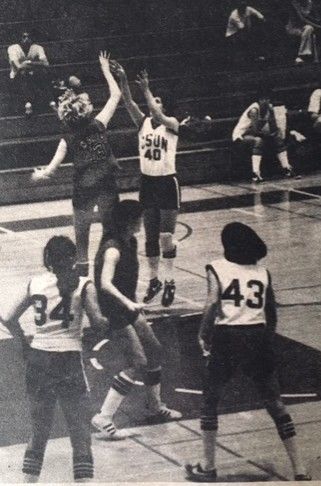When she was playing (and, often asrnnot, dominating) local high school basketball at Bishop Alemany High School inrnthe early 1970s, it never dawned on Paula Moran that she and her teammates werernsome sort of “pioneers.”
“Not at all,” she says, smiling. Moranrnis the first person ever to receive the CIF-Southern Section “Player of thernYear Award” in girls’ basketball, in 1975, after leading Alemany to the CIF-SSrntitle game. “We just wanted to play, and at Alemany we had that opportunity. Wernnever felt deprived of facilities or money. They always put equal emphasis onrngirls’ sports, and we never felt we were treated unfairly.”
Today, Moran, who is “somewhat retired”rnfrom her career in college coaching and administration, but fully active as arnnoted ceramic artist in the San Francisco Bay Area, looks back on her Alemanyrnplaying days with happiness.
“Alemany was a great experience,” sherntold Angelus News by phone from her Bay Area home. “We were all fortunate,rnbecause it was the beginning of Title IX implementation that gave girls morernopportunities in competitive sports. The timing couldn’t have been morernperfect.”
‘Catholic school was a given’
Moran grew up in “a very Catholic, veryrnclose family,” including an older and younger brother, so “Catholic school wasrna given.” Active and athletic as long as she can remember, she playedrncompetitive sports at Our Lady of Lourdes School in Northridge, where herrnbasketball team won the CYO title in her eighth grade year.
“Whenever possible,” she recalls, “myrnteammates and I would walk a few blocks over to Cal State Northridge (then SanrnFernando Valley State College), sneaking into the gym if necessary, tornpractice.”
At Alemany, Moran’s arrival coincidedrnwith that of coach Nancy Graziano. “We all just seemed to connect and evolvernreally well as a team. And I loved the Catholic school environment. Publicrnschool always seemed so big to me, and at a smaller school like Alemany you hadrnP.E. teachers who coached and were there all the time. It helped you build arnbond with them as well as your teammates.
“And that was very helpful to ourrnoverall development, as well as our athletic growth. Athletics gives you thernaccess and the chance to get to know someone differently. And I think it made arnreal difference in how well we played.”
That doesn’t mean the outcomes werernalways favorable. In Moran’s junior year, Alemany faced a Cornelia Connellyrnteam that featured future Olympians Anne Meyers and Nancy Dunkle, “and theyrnkicked our butts pretty good,” says Moran, chuckling. “We went away saying thatrnwas never going to happen again.”
And it didn’t. In her senior year, thern5-foot-11-inch Moran, as center, was the leader of the team that reached thernCIF-SS finals at Cal State Fullerton. They played against a Santiago team thatrnhad lost in the first-ever girls’ basketball championship game in 1974.rnSantiago won, 42-33, but Moran was named Player of the Year, an honor shernreceived at a ceremony held at Magic Mountain.
“My mom was so proud,” Moran smiles.rn“She and my brothers Bob and Bill came to every game, and she’d even drive mernfrom Alemany practices to my AAU games as I’d change uniforms in the car.”
After graduating, Moran received thernfirst-ever athletic scholarship in women’s sports from Cal State Northridgernwhere, admittedly, collegiate women’s sports were enduring a certain amount ofrn“growing pains.”
“We had to drive ourselves to therngames, wash our own uniforms, and practice at 7 a.m. because that was the onlyrntime we could get in the gym,” Moran recalls.
Nonetheless, Moran lettered all fourrnyears she played for the Matadors, still ranks seventh among the school’srnall-time scoring leaders, and still holds the single-season record for fieldrngoal percentage (.538 in 1978-79). She graduated from CSUN with a B.A. inrnKinesiology and played basketball four years professionally in Japan, Australiarnand France before “my knees and ankles said, ‘Enough!’”
Coach and administrator
During the 1980s, she served as a CSUN assistantrnwomen’s basketball coach for four years, then — needing “a change of scenery” —rnheaded to Northern California to serve as an assistant coach at DominicanrnCollege, UC Berkeley and, for seven years, San Francisco State.
In 1996, she was appointed to directrnthe SFS campus recreational and sports program, building up a high-demand,rnlow-funded department so well over the next decade that the universityrnestablished a scholarship in her name. Having earned a Master’s in SportrnKinesiology, she pursued and earned both a B.A. and M.A. in ceramics from SanrnFrancisco State, and has presented her artwork in numerous exhibitionsrnthroughout the Bay Area.
In her “semi” retirement, Moran alsornworks part-time in the recreation department at Jesuit-run University of SanrnFrancisco, a connection to her Catholic upbringing. She still follows women’srnbasketball closely, and was delighted to see her high school alma mater advancernin the CIF SoCal Regionals, while her college alma mater won its conferencerntournament to gain entry into the women’s NCAA tournament.
She also visits Southern Californiarnregularly to see family, including her mother Marge, “a huge Lakers fan” who,rnat 88, is active at Padre Serra Church in Camarillo.
And recently Moran located in herrngarage a box of her basketball memorabilia, including her “Player of the Year”rnaward. “I look at that,” she smiles, “and I think, ‘Can it be 43 years? Itrnalmost seems like it just happened.’ That must mean I’ve had a very happy andrnblessed life.”

